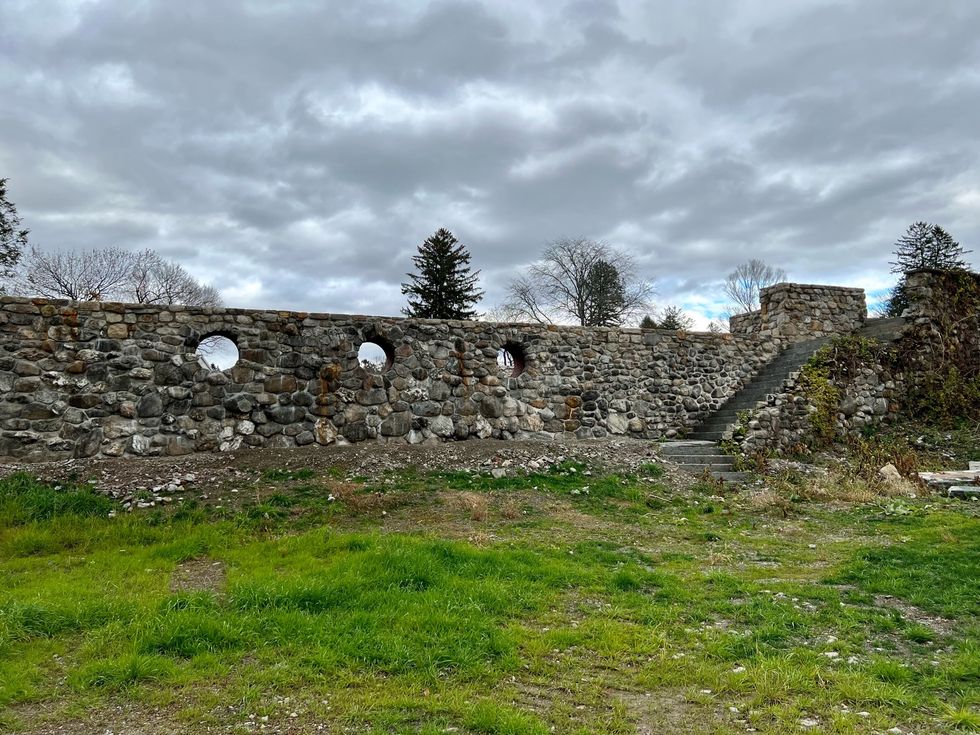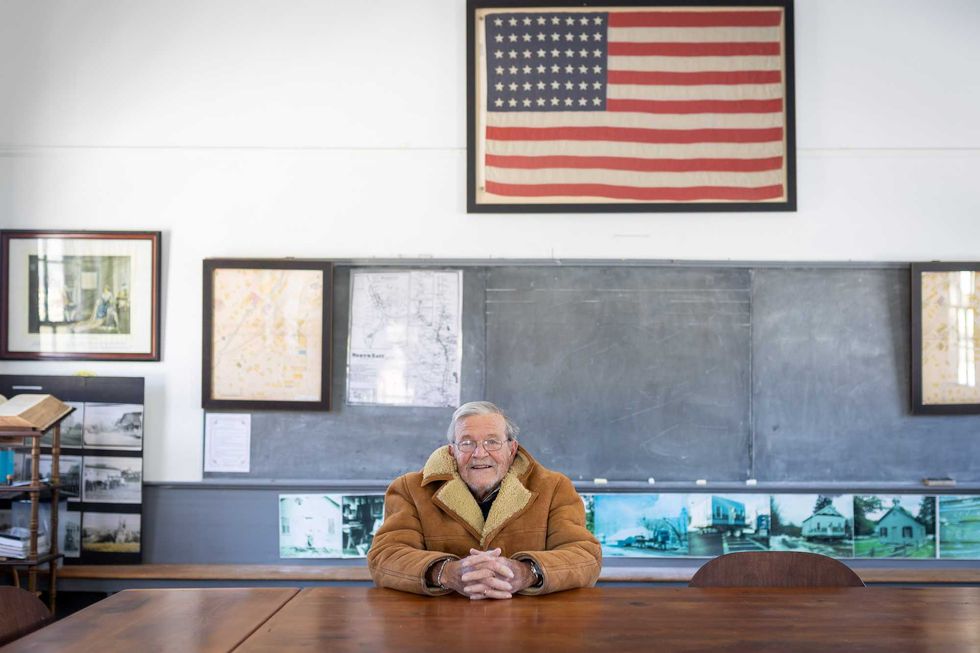Bennett Park, the Thorne Building: where they are now

The wall is built of stones original to Halcyon Hall. During construction it is being reinforced and expanded.
Photo by Judith O’Hara Balfe

MILLBROOK — Coming into Millbrook from Route 343 and turning onto Franklin Avenue, one immediately knows that something is missing: Yes, the Halcyon Hall structure is gone after years of watching it deteriorate, looking like a haunted mansion. Now there is nothing, just empty space.
What’s next? If one looks closely, there is something in the field: a stone wall, and, yes, there is a story behind the building of that wall, but that comes later.
What else is happening now that the buildings are leveled? There was some talk early on about the park opening in late 2022, but that’s not happening. After all, 32 acres of land have to be landscaped, and that includes building trails for walking and biking that will connect with existing trails that leading into the Village. The opening date will more than likely be in 2023.
Other plans include a Bennett College museum and a visitor’s center. Last but not least, there are plans to include amenities for outdoor venues for musical and theatrical performances. All of this takes careful planning, and the Millbrook Community Partnership (MCP) is planning for the very best.
In September, MCP announced that Suzie Kovner had joined its board of directors. A patron of the arts, Kovner brings special expertise to the musical and arts portions of both Bennett Park and the Thorne Building Community Center, which plans to have a performing arts center for dramatic arts, as well as dance, music, lectures, film offerings and many social events. It will also contain a dance class studio and a music/recording studio.
The $554,000 grant received by the MCP from County Executive Mark Molinaro in February 2022 will help, but is only part of the $21 million needed for restoration of the two-pronged project of the Thorne Building Community Center and the Bennett Park initiative, which are both under the auspices of MCP. Much of the funding so far has been raised by private donations, but a major fundraising campaign by the 501(c)(3) will be undertaken soon.
The project has actually moved quickly since the MCP was formed, and it has done so in a very public and transparent way, with several public meetings called to discuss what was wanted from each of these projects. Thus, the community feels very invested in both the Thorne Building Community Center and the Bennett Park project.
Those who had a connection to the old Bennett College will be pleased that the educational center, a well-respected woman’s liberal arts college, will be remembered and lauded at the Bennett museum. A second bandshell may also be in the plans, as music seems to be an integral part of Millbrook, evidenced by the many concerts arranged by the Millbrook Arts Group each year, and the summer “Music in the Streets” for the pleasure of Saturday visitors and shoppers.
When announcing the appointment of Kovner, Oakleigh Thorne, president of MCP, mentioned that her background and knowledge of the arts would indeed by invaluable as the project enters its next phase of development. So we know that progress is being made, and when the Thorne Building was opened to the public for tours on Saturday, May 28 it was finally possible to see how beautiful the building was, the possibilities it held, and how much work still needed to be done. But once again, the public felt invested in the project.
As winter settles in, we may see less movement on the Bennett site, but with the opening planned for 2023, there may be a lot of activity beginning in the spring. By summer, there may be hiking on the trails, music in the air and an influx of visitors to enjoy even more of Millbrook.
Now, as promised, the story behind the wall in the field at Bennett Park.
The wall shown in the picture is built of stones original to Halcyon Hall, but during construction it is being reinforced and expanded.
When Halcyon Hall was torn down, the crew was were able to salvage stone to be used throughout the park, so there will always be reminders of the original buildings and the history of Bennett College.

Suzie Kovner Photo provided
Ralph Fedele sits at a desk in the historic Irondale Schoolhouse, which he led the effort to relocate to downtown Millerton.
MILLERTON — After serving for 12 years on the North East Town Board, Ralph Fedele says he has only one regret.
“I wish I could be called a ‘local,’” he joked with a warm, booming laugh.
Fedele moved to Millerton from New York City 37 years ago, in 1988, and has since worn many hats — volunteer, historian, advocate, elected official — yet he still doesn’t believe he’s earned that title.
“I’m a transplant,” he said matter of factly. “I’m from the city.”
Before settling in Millerton, Fedele spent 25 years working in merchandising at JCPenney.
His roots, however, trace back to Rhinebeck, where he grew up on a 97-acre farm and enjoyed what he describes as an idyllic childhood.
“It was marvelous,” he said, with a twinkle of nostalgia in his eyes. As a boy, he climbed apple trees, spent hours in the family barn’s hayloft, played with neighbors until sunset, and helped his Sicilian grandmother — his nonna — in the garden. Today, Fedele wears her ring. “Any time I’m a little depressed or I want to remember,” he said, “I can talk to her.”
Growing up with an Italian grandmother sparked a lifelong love of history and culture. That curiosity eventually took Fedele to Italy, where he visited the church in which his grandmother was baptized. “Because I love history so much, I wanted to know where my grandmother was from, so I traveled to her village in Sicily.”
Along the way, he uncovered another piece of family history. His great-grandfather, Giovanni Nicolini, was a noted Italian sculptor whose work still stands outside Palermo’s Teatro Massimo, the largest opera house in Italy. Fedele later made a pilgrimage there and photographed his ancestor’s name on the bronze plaque outside of the theater.

The Irondale Schoolhouse
Years after settling in Millerton full time, Fedele was driving north on Route 22 when he spotted an old, classic building and couldn’t stop thinking about it.
“It was in dire straits,” he recalled. “Right on the road, but beautiful. I remember thinking, ‘Wouldn’t that be a great building to move into the village?’”
That moment would eventually turn into Fedele’s lasting legacy.
He left his post at the North East Historical Society to found Friends of the Irondale Schoolhouse, leading an eight-year effort to “move, restore, and repurpose the building.”
Supervisor Chris Kennan said the project remains inseparable from Fedele’s name. “Every time I pass by the Schoolhouse, I think of Ralph,” Kennan said. “It was his vision and persistence that enabled this dream to become a reality.”
Fedele joked that people may have thought he was crazy during the lengthy restoration. “I was a tyrant,” he said with a laugh. “I really made sure that we were able to get it done.” The effort required coordination with the state, the county, village and town officials, and his newly assembled nonprofit board.
As a self-proclaimed history buff, Fedele didn’t stop at the restoration. He found a list of students in old records and did what any determined historian would do. He opened the telephone book and started making calls.
Eventually, he tracked down one of the schoolhouse’s original students — Mary (Mechare) Leitch — who, at the age of 101, returned to the building after renovations were complete.
“It was a marvelous time,” smiled Fedele. “I was so happy to see her.”
‘Trust is earned’
Today, even though he won’t call himself a local, Fedele is a familiar fixture in town. You can find him each week enjoying conversation and a cup of coffee at Talk of the Town Deli, or getting stopped in town by neighbors and friends for a chat.
“I have gained the trust and confidence of a lot of people,” Fedele said. “It comes a little bit at a time. Trust is earned.”
Not only has Fedele served as a town board member, he has volunteered for Townscape and served as the president of the North East Historical Society. He was also one of the first advocates of preserving history by fixing toppled gravestones at the Spencer’s Corners Burying Ground.
His service was formally recognized at his final Town Board meeting through a resolution commending his three four-year terms as councilman, citing his “good humor, kindness to all and deep concern for the community’s senior citizens and for those living on fixed incomes.”
An emotional Fedele addressed the room with a mantra he often repeats. “When you leave, leave this place a little bit better than you found it,” he said. “That’s what I have always tried to do.”
Neighbors react
During the public comment, several residents stood to thank Fedele.
Claire Goodman, a member of the village Zoning Board of Appeals and Townscape volunteer, said Fedele was among the first to welcome her to Millerton.
“Whether we’re standing out in the cold, scrubbing tombstones at Spencer’s Corners, or ringing the bell at the schoolhouse, you always have such grace and you’re such a gentleman.” She added, “The way you laugh, it opens my heart.”
Kathy Chow, who serves on the Conservation Advisory Council and the Climate Smart Task Force, referred to Fedele as a “pitbull,” adding, “We all have hard things that we do, and we keep pushing at it, but you’re the one who makes me think I can keep going.”
Fedele describes his retirement from the town board as bittersweet. “I’m going to miss this,” he said. “I really am.”
Mad Rose Gallery on Route 44 in the Village of Millerton is decked out with lights and decorations to celebrate the holiday season.
MILLERTON — The Village of Millerton is inviting residents and businesses to enter its annual house decorating contest, with judging now underway through Dec. 28.
Awards will be presented in several categories, including Best Lights, Most Creative, Best Overall and Best Commercial Front.
Entries will be evaluated by a panel of judges using established criteria. Creativity will be judged based on originality, variety of materials used and the use of homemade vs. commercially made decorations. Appearance will consider color coordination, balance and overall attractiveness, while effort will reflect the time and energy put into preparation and presentation.
Judging will be conducted by drive-by observation between 6 p.m. and 11 p.m., and displays must be clearly visible from the street side of the house at night. People and pets may not be included as part of the design.
Winners in each category will receive a gift basket, gift certificates and recognition in The Millerton News. Awards will be distributed on Friday, Jan. 9, 2026.
The contest is open to residents and businesses in the Village of Millerton and the Town of North East. Entry forms can be obtained from Village Hall or at villageofmillerton-ny.gov.